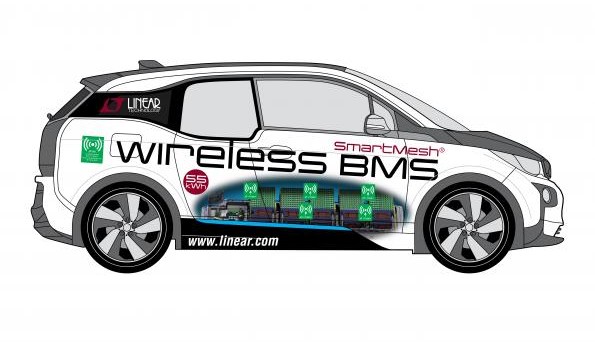My first wireless e-car and it’s not a toy
November 21, 2016
on
on

At the electronica 2016 exhibition, Linear Technology drew large crows with their BMW i3 'concept car' in which the internal communications between battery management boards within the main traction battery pack are implemented by wireless links. LT was using its own Dust Networks 2.4-GHz mesh networking.
The Wireless BMS concept car, actually developed by Linear’s design partner LION Smart, combines battery stack monitors with SmartMesh wireless mesh networking, replacing the conventional wired connections between the battery packs and the battery management system. Benefits, Linear says, “include the potential for improved reliability, lower cost and weight, and reduced wiring complexity for large multicell battery stacks for electric and hybrid/electric vehicles. “
The demo also used battery packs from Kreisel Electric, who build battery packs that are liquid cooled, and heated, with a system integrated with the car's HVAC system. Optimum charging, the collaborating companies explain, can only take place when the battery pack is at a constant 30 degrees C, and heating as well as cooling may be required. The partners claim that given sufficient available power, charging to 80% in 18 minutes is feasible.
I am sure hackers look forward with glee to any attempt of the car industry to move to all-wireless in-vehicle system communications. A simple spark transmitter will present a major challenge to the “RF mesh” inside the Beamer.
The Wireless BMS concept car, actually developed by Linear’s design partner LION Smart, combines battery stack monitors with SmartMesh wireless mesh networking, replacing the conventional wired connections between the battery packs and the battery management system. Benefits, Linear says, “include the potential for improved reliability, lower cost and weight, and reduced wiring complexity for large multicell battery stacks for electric and hybrid/electric vehicles. “
The demo also used battery packs from Kreisel Electric, who build battery packs that are liquid cooled, and heated, with a system integrated with the car's HVAC system. Optimum charging, the collaborating companies explain, can only take place when the battery pack is at a constant 30 degrees C, and heating as well as cooling may be required. The partners claim that given sufficient available power, charging to 80% in 18 minutes is feasible.
I am sure hackers look forward with glee to any attempt of the car industry to move to all-wireless in-vehicle system communications. A simple spark transmitter will present a major challenge to the “RF mesh” inside the Beamer.
Read full article
Hide full article



Discussion (0 comments)